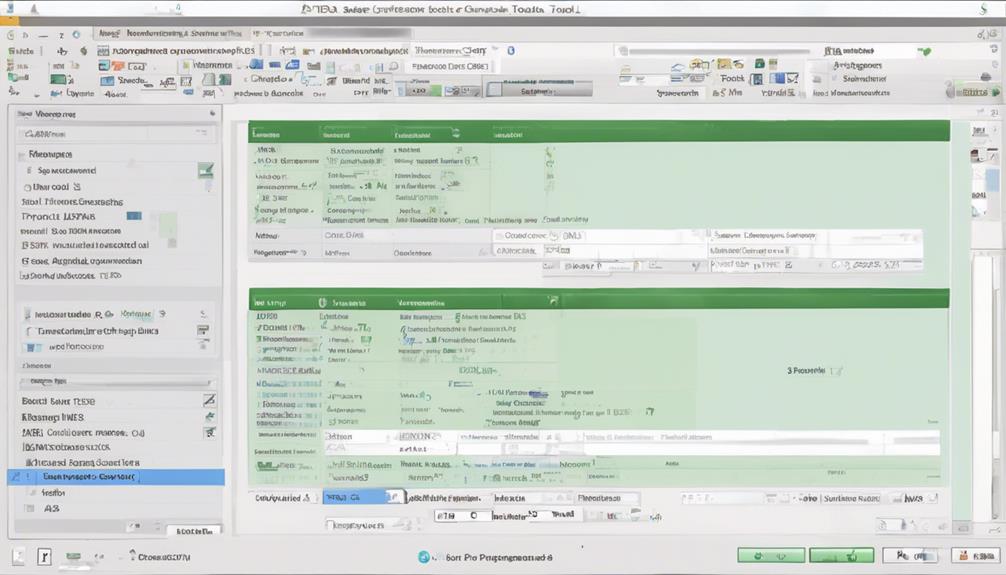Embrace the digital chameleon that adapts to the ever-evolving data landscape. Engage with the cutting-edge trends in bulk data formatting services, where innovation meets efficiency and security head-on. Discover how these 10 transformative trends are reshaping the way data is structured and processed, paving the way for a future where precision and scalability reign supreme. Explore the realms of AI-driven formatting, real-time processing, cloud-based services, and more – each trend holding the key to unlocking new possibilities in data management.
AI-driven Data Formatting
When it comes to data formatting, the integration of AI technology has revolutionized the process, enhancing efficiency and accuracy. AI-driven data formatting leverages advanced algorithms to streamline the conversion of raw data into structured formats. Data visualization techniques play a crucial role in this process, enabling the representation of complex datasets in a visual format that is easy to interpret. By utilizing natural language processing applications, AI can analyze unstructured data sources and extract valuable information to aid in formatting tasks.
AI-driven data formatting solutions offer a range of benefits, including increased speed in processing large volumes of data, improved accuracy in data extraction and transformation, and enhanced scalability to handle diverse data formats. These technologies enable organizations to automate repetitive formatting tasks, reducing manual errors and saving time. Additionally, the integration of AI enhances data quality by ensuring consistency and adherence to predefined formatting standards.
Real-time Data Processing
Real-time data processing offers you the ability to receive instant data updates, enabling you to make quick and informed decisions based on the most up-to-date information available. With automated data analysis, you can streamline processes, identify patterns, and extract valuable insights in real-time, enhancing your overall operational efficiency and strategic decision-making. By leveraging these capabilities, you can stay ahead of the curve and adapt swiftly to changing market dynamics.
Instant Data Updates
For efficient and accurate data management, our Bulk Data Formatting Services offer an advanced feature known as Instant Data Updates. This feature ensures data accuracy by allowing real-time updates to be processed instantly. By implementing Instant Data Updates, you can rely on the most up-to-date information at all times, enhancing the quality and reliability of your data.
Instant updates through our service enable you to make quick decisions based on the latest data available. Whether you are working with large datasets or frequent updates, Instant Data Updates streamline the process, saving you time and reducing the margin of error.
With Instant Data Updates, you can maintain a competitive edge in today’s fast-paced business environment. By staying current with the most recent data modifications, you can respond promptly to changes and opportunities in the market.
Automated Data Analysis
Utilizing automated data analysis, our Bulk Data Formatting Services provide real-time data processing capabilities that enhance the efficiency and accuracy of your data management processes. By implementing cutting-edge data visualization strategies, we enable you to gain valuable insights and identify patterns quickly. Through automated data analysis, you can streamline your decision-making processes and respond promptly to changing trends.
Moreover, our services include robust data quality assessment measures to ensure the integrity and reliability of your information. By continuously monitoring and analyzing data quality metrics, we help you maintain high standards and prevent errors or inconsistencies that could impact your operations.
Automated data analysis not only accelerates the processing of large datasets but also improves the overall quality of your data management practices. With our real-time data processing capabilities and emphasis on data visualization and quality assessment, you can make informed decisions swiftly and confidently.
Cloud-based Formatting Services
When considering data formatting services in the cloud, one cannot overlook the efficiency and flexibility that cloud-based formatting services offer. In the realm of data visualization tools, cloud-based formatting services enable seamless integration with various visualization platforms, allowing you to transform raw data into visually appealing representations effortlessly. Moreover, these services provide robust data quality control mechanisms, ensuring that your formatted data is accurate and reliable for analysis.
Cloud-based formatting services streamline the process of formatting large volumes of data by leveraging the scalability and accessibility of cloud computing. This scalability allows you to process vast amounts of data quickly and efficiently, saving you time and resources. Additionally, the flexibility of cloud-based services enables you to adapt to changing formatting requirements easily, ensuring that your data remains structured and organized.
Automated Data Transformations
Considering the efficiency and flexibility offered by cloud-based formatting services, the focus now shifts to the realm of automated data transformations. Automated data transformations play a crucial role in streamlining processes and enhancing productivity. By automating tasks such as data cleaning, normalization, and enrichment, organizations can save time and reduce manual errors.
Data visualization techniques are commonly integrated into automated data transformations to provide a clear and intuitive representation of processed data. These techniques enable users to identify patterns, trends, and anomalies more effectively, leading to better decision-making and actionable insights.
Moreover, automated data transformations contribute significantly to data quality assurance. By implementing validation checks, error handling mechanisms, and data profiling routines, organizations can ensure that the transformed data meets predefined quality standards. This proactive approach minimizes the risk of data inaccuracies and inconsistencies, ultimately enhancing the reliability and trustworthiness of the processed data.
Data Formatting for Big Data
Enhancing the efficiency of data processing on a large scale, data formatting for big data is a critical aspect of modern data management strategies. When dealing with massive volumes of data, ensuring consistency and accuracy is key to deriving valuable insights. Data normalization plays a vital role in standardizing data formats across various sources, making it easier to analyze and process information efficiently.
Moreover, data cleansing is essential in big data formatting to eliminate errors, duplicates, and inconsistencies that could hinder the quality of analysis. By cleaning and organizing data, you can enhance data accuracy and reliability, leading to more informed decision-making processes.
In the realm of big data, efficient data formatting not only streamlines data processing but also enhances the overall quality and reliability of insights obtained. Embracing data normalization and cleansing practices is fundamental to unleashing the full potential of big data analytics and ensuring that organizations can make well-informed decisions based on accurate and consistent data.
Advanced Data Security Measures
When it comes to advanced data security measures, encryption for data and secure file transfers are crucial components. You need to ensure that your data is protected through robust encryption methods, safeguarding it from unauthorized access or breaches. Implementing secure file transfer protocols adds an extra layer of protection, guaranteeing the safe transmission of sensitive information.
Encryption for Data
To ensure the utmost protection of your data, implementing advanced encryption techniques is paramount. Data encryption plays a crucial role in safeguarding sensitive information and maintaining data privacy. By encoding data in such a way that only authorized parties can access it, encryption acts as a shield against unauthorized access and data breaches.
Encryption for data involves converting plain text information into ciphertext using complex algorithms. This process ensures that even if data is intercepted, it remains unintelligible to unauthorized users. Additionally, encryption helps in securing data both at rest and in transit, providing a comprehensive approach to data protection.
Modern encryption methods, such as Advanced Encryption Standard (AES) and RSA encryption, offer robust security measures to prevent data compromise. These algorithms use sophisticated key management systems to ensure that only authorized users possess the keys required to decrypt the information.
Secure File Transfers
Secure file transfers are a critical aspect of maintaining data integrity and confidentiality in today’s digital landscape. When it comes to compliance management, ensuring that data is securely transferred between systems is essential for meeting regulatory requirements and safeguarding sensitive information. Implementing robust data encryption protocols is key to protecting files during transit, making it significantly harder for unauthorized parties to intercept and access the data.
By utilizing advanced encryption algorithms, organizations can secure their file transfers and mitigate the risk of data breaches. Data encryption scrambles the information being sent, rendering it unreadable to anyone without the decryption key. This added layer of security enhances confidentiality and minimizes the chances of data leaks or unauthorized access.
Incorporating secure file transfer mechanisms not only bolsters data protection but also instills trust among stakeholders. By prioritizing secure file transfers and adherence to compliance standards, businesses can demonstrate their commitment to safeguarding sensitive information and maintaining the integrity of their data assets.
Machine Learning in Data Formatting
Machine learning plays a crucial role in data formatting by automating the process of structuring and organizing large volumes of data. Machine learning applications have significantly enhanced data formatting efficiency by enabling systems to learn from patterns within the data and make intelligent decisions on how to format it effectively. Through algorithms and models, machine learning can identify relationships between different data points, categorize information accurately, and streamline the formatting process.
Integration of IoT Data
Incorporating IoT data into data formatting processes revolutionizes the way organizations handle and extract insights from vast amounts of information. By integrating IoT data, organizations can enhance their data visualization capabilities, allowing for a more intuitive and comprehensive understanding of complex datasets. This integration also facilitates efficient data aggregation, enabling organizations to consolidate data from various sources and formats into a unified structure for analysis.
IoT data integration empowers organizations to create interactive dashboards and reports that provide real-time insights into operations, performance metrics, and trends. This enhanced data visualization not only improves decision-making processes but also enables stakeholders to identify patterns and anomalies more effectively.
Moreover, through effective data aggregation, organizations can streamline the process of collecting, organizing, and formatting data from IoT devices. This aggregated data can then be leveraged for predictive analytics, enabling organizations to make informed decisions and optimize processes based on historical trends and patterns. By integrating IoT data into data formatting services, organizations can unlock valuable insights and drive innovation in their operations.
Predictive Analytics in Formatting
When considering predictive analytics in formatting, it’s crucial to focus on future data patterns and the precision in prediction they offer. By analyzing historical data trends and behaviors, you can anticipate future formatting needs with greater accuracy. This proactive approach enables you to optimize your data formatting processes and enhance overall efficiency.
Future Data Patterns
To understand the potential impact of predictive analytics in data formatting, one must delve into the realm of future data patterns. Future data patterns are being shaped by advancements in data visualization techniques and emerging data standards. Data visualization techniques, such as interactive dashboards and 3D visualizations, are enabling users to extract meaningful insights from complex datasets more effectively. These techniques not only enhance data interpretation but also aid in identifying patterns that can guide decision-making processes.
Additionally, emerging data standards, like XML and JSON, are standardizing data formats across various platforms, making data integration and exchange more seamless. These standards are promoting interoperability and improving data consistency, which is crucial for predictive analytics accuracy. By adhering to these emerging data standards, organizations can ensure that their data is structured in a way that optimizes predictive analytics algorithms for precise forecasting and trend identification. Embracing these future data patterns will undoubtedly revolutionize the way data formatting services operate, paving the way for more efficient and insightful data processing.
Precision in Prediction
With the rapid evolution of technology and the increasing volume of data being generated daily, the need for precision in prediction through predictive analytics in formatting has become paramount. Predictive analytics plays a crucial role in achieving improved accuracy and enhanced insights. By utilizing advanced algorithms and machine learning techniques, predictive analytics can analyze historical data patterns to forecast future trends with a high level of accuracy.
This precision in prediction enables businesses to make informed decisions, optimize processes, and anticipate market changes effectively. Through the identification of hidden patterns and correlations within vast datasets, predictive analytics empowers organizations to proactively address challenges and capitalize on opportunities.
Moreover, the integration of predictive analytics in data formatting services enhances the overall quality of insights derived from the data. By leveraging predictive modeling, businesses can extract valuable information, predict outcomes, and streamline decision-making processes. The emphasis on precision in prediction not only increases operational efficiency but also leads to a competitive advantage in today’s data-driven landscape.
Data Formatting for Blockchain Technology
Amidst the rapid evolution of technology, the importance of data formatting for blockchain technology cannot be overstated. Blockchain integration relies heavily on structured and validated data to ensure the integrity and security of transactions. Data formatting for blockchain involves organizing information in a specific way that allows for efficient processing and verification on the distributed ledger.
When it comes to blockchain integration, the accuracy of data validation is paramount. Properly formatted data ensures that transactions are legitimate, preventing errors, fraud, and unauthorized access. By establishing standardized formats and protocols for data input, blockchain technology can operate seamlessly and securely.
Effective data formatting for blockchain technology also enhances transparency and trust among users. Clear and consistent data structures enable easy verification and auditing, contributing to the credibility and reliability of the blockchain network. Embracing precise formatting practices not only streamlines operations but also reinforces the fundamental principles of decentralization and trust within the blockchain ecosystem.
Frequently Asked Questions
Can Bulk Data Formatting Services Handle Non-Structured Data Formats?
Yes, bulk data formatting services can handle non-structured data formats efficiently. They excel in data extraction and text mining tasks, making them versatile tools for managing diverse data sources and converting them into structured formats for analysis.
How Can Data Formatting Services Ensure Data Privacy and Compliance?
To ensure data privacy and compliance, data formatting services must prioritize data encryption to safeguard sensitive information. Additionally, adherence to regulatory requirements is crucial in maintaining legal standards and safeguarding against data breaches or non-compliance issues.
Are There Any Limitations to the Size of Data Processed in Real-Time?
When it comes to processing data in real-time, scalability challenges often arise, leading to restrictions in handling large volumes of data concurrently. It’s crucial to optimize systems to overcome these limitations and ensure efficient operations.
Can Automated Data Transformations Adapt to Changing Data Sources?
Yes, automated data transformations can adapt to changing data sources by incorporating dynamic mapping. This process allows for seamless data integration regardless of variations in data sources, ensuring efficient and accurate processing of information in real-time.
How Does Machine Learning Improve Accuracy in Data Formatting Tasks?
Machine learning enhances data quality by analyzing patterns and refining formatting algorithms. It enables automation to adapt to diverse data sources, improving accuracy. Overcoming scalability challenges, machine learning optimizes bulk data formatting services efficiently and effectively.



